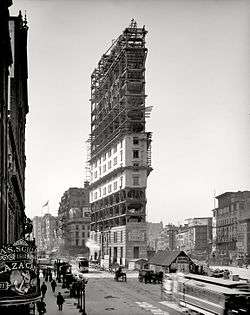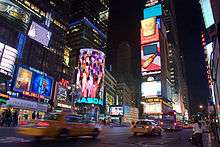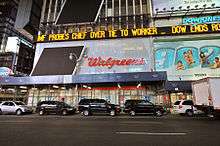One Times Square
| One Times Square | |
|---|---|
.jpg) One Times Square in 2010 | |
| General information | |
| Location | 1 Times Square, New York, NY 10036 |
| Coordinates | 40°45′23″N 73°59′11″W / 40.756421°N 73.9864883°WCoordinates: 40°45′23″N 73°59′11″W / 40.756421°N 73.9864883°W |
| Completed | 1904 |
| Owner | Jamestown, L.P. and Sherwood Equities |
| Height | |
| Roof | 363 ft (111 m) |
| Technical details | |
| Floor count | 25 |
| Floor area | 110,599 sq ft (10,275.0 m2) |
| Design and construction | |
| Architect | Cyrus L.W. Eidlitz, Andrew C. McKenzie (presently HLW International) |
| Developer | The New York Times |
| References | |
| [1][2][3] | |
One Times Square, also known as 1475 Broadway, the New York Times Building, the New York Times Tower, or simply as the Times Tower, is a 25-story, 363-foot-high (111 m) skyscraper, designed by Cyrus L. W. Eidlitz, located at 42nd Street and Broadway in New York City.
The tower was originally built to serve as the headquarters of The New York Times, which officially moved into the tower in January 1905. Eight years later, the paper moved to a new building, 229 West 43rd Street. Even after the Times left, One Times Square remained a major focal point of Times Square due to its annual New Year's Eve "ball drop" festivities, and the introduction of an electronic news ticker at street-level in 1928.
Following its sale to Lehman Brothers in 1995, One Times Square was re-purposed as an advertising location to take advantage of its prime location within the square. Most of the building's interior remains vacant (aside from its only major tenant, a Walgreens pharmacy which occupies its lower levels), while its exterior features a large number of traditional and electronic billboards. Due to the large amount of revenue generated by its ads, One Times Square is considered one of the most valuable advertising locations in the world.
Building history
The new building, on the site of the Pabst Hotel, was completed in 1904 to serve as the headquarters of The New York Times, which officially moved into the building in January 1905.[4][5][6] The paper's owner, Adolph Ochs, also successfully persuaded the city to rename the surrounding area (then known as Longacre Square) after the newspaper, becoming Times Square.[7][5][8] To help promote the new headquarters, the Times held a New Year's Eve event on December 31, 1903, welcoming the year of 1904 with a fireworks display set off from the roof of the building at midnight.[6][8][9] The event was a success, attracting 200,000 spectators, and was continued annually until 1907.[8][9] For 1908, Ochs replaced the display with what he thought would be a more spectacular event—the lowering of a lit ball down the building's flagpole at midnight, patterned off the use of time balls to indicate a certain time of day (the "ball drop" is still held on One Times Square to this day, attracting an average of one million spectators yearly).[9][7][10]

In 1913, only eight years after it moved to One Times Square, the Times moved its corporate headquarters to 229 West 43rd Street,[7][10] which served as its home from 1913 to 2007. The Times has since moved to The New York Times Building on nearby Eighth Avenue. After leaving One Times Square, the Times still maintained ownership of the tower.[11][12][13]
On November 6, 1928, an electronic news ticker known as the Motograph News Bulletin (colloquially known as the "zipper") was introduced near the base of the building. The zipper originally consisted of 14,800 light bulbs, with the display controlled by a chain conveyor system inside the building; individual letter elements (a form of movable type) were loaded into frames to spell out news headlines. As the frames moved along the conveyor, the letters themselves triggered electrical contacts which lit the external bulbs (the zipper has since been upgraded to use modern LED technology).[4][14][12] The first headline displayed on the zipper announced Herbert Hoover's victory in that day's presidential election. The zipper was used to display other major news headlines of the era, and its content later expanded to include sports and weather updates as well.[14][12] On the evening of August 14, 1945, the zipper was famously used to announce Japan's surrender from World War II to a packed crowd in Times Square.[15]

The Times sold the building to advertising executive and sign designer Douglas Leigh in 1961.[16][10][17] Leigh then sold the building to Allied Chemical in 1963.[16][10][17] Allied Chemical greatly modified the building's facade in a $10 million renovation, replacing intricate granite and terracotta elements with marble facing. In 1974, the building was sold to investor Alex Parker for $6.25 million, and then to the Swiss-based investment group Kemekod. Kemekod later sold the tower to an investment group led by Lawrence I. Linksman in 1982. Linksman promised further renovations to the building, including the possibility of using its north face for signage displays.[16][18][17]
Following the sale of the building by the Times, the zipper was operated on an inconsistent basis by various news outlets, and was shut off entirely between 1961 and 1965, and again from 1977 to 1986. In 1986, the ticker was revived by Newsday, which operated it until December 31, 1994. The newspaper declined to renew its lease on the ticker, believing that they "[didn't] get very much out of that sign" financially.[18][15][19] Publishing company Pearson PLC operated the zipper for a period beginning on December 31, 1994, until ceding its role to Dow Jones & Company in June 1995.[20][21]
From 1990 to 1996, Sony operated a Jumbotron on the exterior of the tower. Alongside its use for advertising and news, it was also frequently used by the producers of the late-night talk show Late Show with David Letterman, who could display a live feed from its studio on the screen as well. As a cost-saving measure, Sony declined to renew its lease of the space, leading to the subsequent removal of the Jumbotron in June 1996. Due to its frequent use by Late Show, its producer Rob Burnett jokingly considered the removal of the Jumbotron to be "a sad, sad day for New York."[22]
One Times Square has continued to house tenants in its ground-level floors: in the late 1990s, a Warner Bros. retail store filled the first three floors.[23] In early 2006, the floors were occupied by a J. C. Penney pop-up store known as The J C. Penney Experience.[24] In November 2008, pharmacy chain Walgreens opened a new flagship store in the space, renting it in a lease valued at $4 million yearly. Walgreens also introduced a new digital sign to the building as part of its grand opening: designed by Gilmore Group and constructed by D3 LED, the 17,000-square-foot (1,600 m2) sign runs diagonally up both sides of the building and contains 12 million LEDs, surpassing the nearby NASDAQ sign as the largest LED sign in Times Square.[8][25] The former electrical room in the tower's basement currently serves as a "vault" for the storage of items relating to New Year's Eve celebrations at Times Square, including the ball itself (prior to 2009), spare parts, numeral signage and other memorabilia.[26]
In September 2017, the building's owners unveiled plans to use much of the building's vacant space. Under the proposal, a museum dedicated to the history of Times Square would be built on the 15th through 17th floors, and the 18th floor would contain a new observatory. The ground level would also be renovated to provide an expanded entrance to the New York City Subway's Times Square–42nd Street station, which is directly underneath the building. Work would be completed by fall 2018.[27]
Billboards


In 1992, the owners of One Times Square filed for bankruptcy protection.[15] In March 1995, One Times Square was sold to the financial services firm Lehman Brothers for $27.5 million. The new owners felt that it would not be cost-effective to house new tenants in the tower due to the cost of the extensive renovation required in order to make it suitable for tenants as compared to the relatively small rental revenue that its limited floor space would have brought in. Instead, they decided to market the tower as a location for advertising to capitalize on its prominent location within the Square. The entire exterior of One Times Square above the ticker was modified to add a grid frame for mounting billboard signs.[28][29][30]
Throughout 1996, One Times Square's first electronic billboards were installed, such as, a Cup Noodles billboard with steam effects was added to the front of the tower, later accompanied by an animated Budweiser sign. In October, a 55-foot video screen sponsored by ITT Corporation was introduced to the top of the tower, which would feature video advertisements and community service announcements.[31][32] In December 1996, a Panasonic display operated by NBC known as Astrovision was introduced as a replacement for Sony's Jumbotron at the base of the tower.[30][33][8]
Lehman Brothers sold One Times Square in 1997 to the Jamestown, L.P. for $117 million. Filings related to the sale revealed that the billboards on the tower had been generating a net revenue of $7 million yearly, representing a 300% profit.[23] With growing tourism and high traffic in the Times Square area (with a yearly average of over 100 million pedestrians—alongside its prominence in media coverage of New Year's festivities, seen by a wide audience yearly), annual revenue from the signs grew to over $23 million by the year 2012—rivaling London's Piccadilly Circus as the most valuable public advertising space in the world.[34][35]
Advertisers

From 1996 to 2006, Nissin Foods operated a Cup Noodles billboard with smoke effects (an effect that had also been famously used by other Times Square billboards, such as the Camel Cigarettes sign).[31] The Cup Noodles billboard was replaced in 2006 by a General Motors billboard featuring a Chevrolet branded clock; however, as a part of cutbacks resulting from GM's bankruptcy and re-organization, the Chevrolet Clock was removed in 2009 and eventually replaced by the current Dunkin' Donuts display.[36]
On August 19, 1998, Discover Card replaced ITT Corporation as the operator and sponsor of the top-most screen on One Times Square as part of a ten-year deal. The deal came alongside the announcement that Discover Card would be an official sponsor of Times Square's New Year's Eve 2000 festivities.[37]
In 2006, News Corporation (now 21st Century Fox) replaced NBC as the operator and sponsor of the Astrovision screen.[38] In 2010, Sony returned to One Times Square by replacing the News Corp. Panasonic screen with a new high-definition LED display.[39]
In December 2007, Toshiba took over sponsorship of the top-most screen of One Times Square from Discover Card in a 10-year lease.[40] Throughout 2008, upgrades began to be made to the upper portion of One Times Square; including the installation of new Toshiba high definition LED displays (known as ToshibaVision), and the redesign of its roof to accommodate a larger New Year's Eve ball, which became a year-round fixture of the building beginning in 2009.[26][41]
On November 23, 2017, Toshiba announced that it would end its One Times Square sponsorship in early 2018, citing ongoing cost-cutting measures.[42][43][44]
References
- ↑ "One Times Square". CTBUH Skyscraper Database. Council on Tall Buildings and Urban Habitat. 2016. Archived from the original on November 17, 2016.
- ↑ "Allied Chemical Building". CTBUH Skyscraper Database. Council on Tall Buildings and Urban Habitat. 2016. Archived from the original on November 18, 2016.
- ↑ "1 Time Square". Emporis. 2016. Archived from the original on March 5, 2016.
- 1 2 Young, Greg; Meyers, Tom (2016). The Bowery Boys: Adventures in Old New York: An Unconventional Exploration of Manhattan's Historic Neighborhoods, Secret Spots and Colorful Characters. Ulysses Press. p. 289. ISBN 9781612435763.
- 1 2 Barron, James (April 8, 2004). "100 Years Ago, an Intersection's New Name: Times Square". The New York Times. Archived from the original on December 24, 2015.
- 1 2 Brainerd, Gordon (2006). Bell Bottom Boys. Infinity Publishing. p. 58. ISBN 9780741433992.
- 1 2 3 McKendry, Joe (2011). One Times Square: A Century of Change at the Crossroads of the World. David R. Godine Publisher. pp. 10–14. ISBN 9781567923643.
- 1 2 3 4 5 Crump, William D. (2014). Encyclopedia of New Year's Holidays Worldwide. McFarland. p. 242. ISBN 9781476607481.
- 1 2 3 Boxer, Sarah B. (December 31, 2007). "NYC ball drop goes 'green' on 100th anniversary". CNN. Archived from the original on January 3, 2014.
- 1 2 3 4 Lankevich, George J. (2001). Postcards from Times Square. Square One Publishers. p. 20. ISBN 9780757001000.
- ↑ "History of Times Square". The Telegraph. London. July 27, 2011. Archived from the original on March 10, 2016.
- 1 2 3 Long, Tony (November 6, 2008). "Nov. 6, 1928: All the News That's Lit". Wired. Archived from the original on November 9, 2008.
- ↑ "The New York Times Company Enters The 21st Century With A New Technologically Advanced And Environmentally Sensitive Headquarter" (PDF) (Press release). The New York Times Company. November 16, 2007. Archived from the original (PDF) on February 27, 2008.
- 1 2 Poulin, Richard (2012). Graphic Design and Architecture, A 20th Century History: A Guide to Type, Image, Symbol, and Visual Storytelling in the Modern World. Rockport Publishers. p. 53. ISBN 9781592537792.
- 1 2 3 Gelder, Lawrence van (December 11, 1994). "Lights Out for Times Square News Sign?". The New York Times. Archived from the original on May 8, 2016.
- 1 2 3 Randall, Gabrielan (2000). Times Square and 42nd Street in Vintage Postcards. Arcadia Publishing. p. 16. ISBN 9780738504285.
- 1 2 3 Josephs, Larewnce (3 January 1982). "A New Owner Takes the Reins in Times Square". The New York Times. Archived from the original on 14 July 2014.
- 1 2 Bloom, Ken (2013). Broadway: An Encyclopedia. Routledge. p. 530. ISBN 9781135950194.
- ↑ Sagalyn, Lynne B. (2003). Times Square Roulette: Remaking the City Icon. MIT Press. p. 323. ISBN 9780262692953.
- ↑ "Dow Jones taking over news 'zipper'". Portsmouth Daily Times. Associated Press. 10 June 1995. p. B8. Retrieved January 20, 2013.
- ↑ "Update: Times Square keeps its zip after all". The New York Times. Retrieved January 20, 2013.
- ↑ Lueckmay, Thomas J. (17 May 1996). "Less Glitter on Times Square: No More Jumbotron". The New York Times. Archived from the original on 3 October 2009. Retrieved January 14, 2013.
- 1 2 "Tower in Times Sq., Billboards and All, Earns 400% Profit". The New York Times. Retrieved January 14, 2013.
- ↑ "What's Really Inside". The Village Voice. Retrieved January 15, 2013.
- ↑ Collins, Glenn. "How to Stand Out in Times Square? Build a Bigger and Brighter Billboard". The New York Times. Retrieved January 14, 2013.
- 1 2 "When Party Is Over, the Ball Lands Here". The New York Times. Retrieved January 15, 2013.
- ↑ Chen, Jackson (September 28, 2017). "Times Sq. Museum Aims To Steer Tourists Away From 'Elmos and Topless Women'". DNAinfo New York. Archived from the original on September 28, 2017. Retrieved September 29, 2017.
- ↑ Levi, Vicki Gold; Heller, Steven (2004). Times Square Style: Graphics from the Great White Way. New York: Princeton Architectural Press. p. 9. ISBN 9781568984902.
- ↑ Brill, Louis M. "Signage in the crossroads of the world". SignIndustry. Retrieved January 15, 2013.
- 1 2 Holusha, John. "Times Square Signs: For the Great White Way, More Glitz". The New York Times. Retrieved January 15, 2013.
- 1 2 Glenn, Collins. "How do you get your message across among the Times Square throng? Try turning up the steam". The New York Times. Archived from the original on December 21, 2013.
- ↑ "Mayor Giuliani Lights Up ITT's Electronic Display Sign in Times Square". City of New York City. Retrieved January 14, 2013.
- ↑ Lewine, Edward. "Times Square: No Remote Can Fix This Screen". Neighborhood Report. The New York Times. Retrieved January 14, 2013.
- ↑ "Ads, Not Tenants, Make Times Square". The Wall Street Journal. Archived from the original on January 11, 2013. Retrieved January 14, 2013.
- ↑ Hellman, Peter (May 19, 1997). "Bright Lights, Big Money". New York Magazine. 30 (19): 48. ISSN 0028-7369.
- ↑ Chang, Richard S. (July 16, 2009). "G.M. Says Farewell to Times Square". The New York Times. Archived from the original on May 6, 2016.
- ↑ Lueck, Thomas J. (July 18, 1998). "Metro Business; Discover Is Sponsor For Year 2000 Event". The New York Times. Archived from the original on March 6, 2016.
- ↑ ?, Brian (October 13, 2006). "News Corp Takes Over Times Sq. Screen". TV Newser. Archived from the original on January 16, 2011.
- ↑ "Sony Corporation of America and News Corporation Partner to Program Digital Space in One of the World's Most Recognized Advertising Locations—Times Square in New York City" (Press release). Sony Corporation of America. July 13, 2010. Archived from the original on October 6, 2011 – via PR newswire.
- ↑ Elliot, Stuart (December 3, 2007). "Back in Times Square, Toshiba Stands Tall". The New York Times. Archived from the original on December 27, 2016.
- ↑ Temistokle, Eddie (December 7, 2009). "Make Your Way to the Big Screen: Toshiba Introduces 'I'm on TV' Feature to Toshiba Vision in Times Square" (PDF) (Press release). Toshiba America. Archived from the original (PDF) on November 23, 2010.
- ↑ "Cash-strapped Toshiba bids farewell to Times Square and 'Sazae-san'". The Japan Times Online. 2017-11-22. ISSN 0447-5763. Retrieved 2017-12-05.
- ↑ "Worker survives fall from Toshiba sign in Times Square". New York Post. 2018-05-30. Retrieved 2018-06-05.
- ↑ "Changing times: Toshiba's New York billboard goes dark". Nikkei Asian Review. Retrieved 2018-06-05. (subscription required)
External links
| Wikimedia Commons has media related to One Times Square. |
.png)